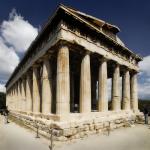|
This section contains 1,513 words (approx. 6 pages at 300 words per page) |

|
Defining Professionals.
The dividing line between the amateur and the professional dancer in ancient Greek society is not an easy one to draw. The first tragedian, Thespis, was not only a dancer but he also taught dance, and so did all the early tragic poets. Sophocles received instruction from Lamprus, a famous teacher of dance and music who was also well-known for his abstention from wine, which was unusual among the practitioners of mousike—music, dance, and poetry. Even the tragic poet Aeschylus, who did his own choreography, used the services of a dancing master. Yet even though choristers and dancing masters might be paid, they were considered non-professional. The fifty men who sang and danced the dithyrambs in Athens did not dance full-time, meaning they had other occupations that represented their primary work and so were not considered professional dancers. Dancers who entertained at banquets...
|
This section contains 1,513 words (approx. 6 pages at 300 words per page) |

|




